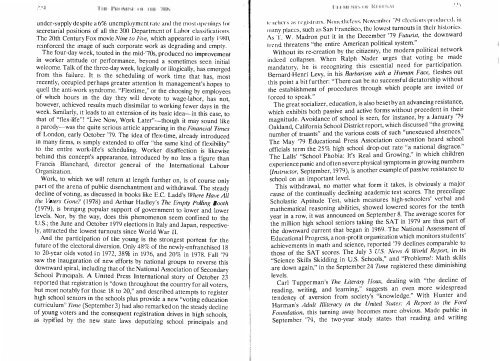CONTENTS - ouroboros ponderosa
CONTENTS - ouroboros ponderosa
CONTENTS - ouroboros ponderosa
Create successful ePaper yourself
Turn your PDF publications into a flip-book with our unique Google optimized e-Paper software.
J.) ·1<br />
undcr-s pply u . cpitc a 6% uncmpl()ymcnt rate anti Ihe lll(}st (}Jl{'lIings li.r<br />
secretanal pos1tlons of all the 300 Department of Lahor c1assificatiolls.<br />
Thc 20th Century Fox movie Nine to Iive, which appeared ill early I ')XO,<br />
rcmforced the ,mage of such corporate work as degrading and emrty.<br />
. The four-day week, touted in the mid-'70s, produced no improvement<br />
m worker attitude Or performance, beyond a sometimcs seen initial<br />
welcome. Talk of thc thrce-day week, logically or illogically, has emerged<br />
from thlS fmlurc. It 1S the scheduling of work time that has most<br />
recently, occpied perhaps greater attention in management's hpes to<br />
quell the antr-work syndrome. "Flextime," or the choosing by employees<br />
of wh,ch hors m the day they will devote to wage-labor, has not,<br />
however, ch1eved results much dissimilar to working fewer days in the<br />
week. S,m1larly, 1t leads to an extension of its basic idea-in this case to<br />
that of "flex-life"! "Live Now, Work Later"-thollgh it may sound like<br />
a parody-was the quite scrious article appearing in the Financial 1Imes<br />
of London, early October '79. The idea of flex-time, already introduced<br />
m many hrs, 1S s1mply extended to offer "the same kind of flexibility"<br />
to the ent1re work-life's scheduling. Worker disaffection is likewise<br />
behmd th1s concept's appearance, introduced by no less a figure than<br />
FrancIS Blanchard, dlfector general of the International Labour<br />
Organlzatron.<br />
Work, to which we win return at length further on, is of course only<br />
part 01 the arena of pubhc d1senchantment and withdrawal. The steady<br />
declme of votmg, as discussed in books like E.C. Ladd's Where Ha ve All<br />
the VO lers Gone? (1978) and Arthur Hadley's The Emply Polling Booth<br />
(1979), ,s bnnglllg popular support of government to lower and lower<br />
levcls. Nor, by the way, does this phenomenon seem confined to the<br />
U.S.; the June and October 1979 elections in Italy and Japan, respective<br />
ly, attracted the lowest turnouts since World War II.<br />
And the participation of the young is the strongest portent for the<br />
future ot the electoral diversion. Only 48% of the newly-enfranchised 18<br />
to 20-ycar olds voted in 1972, 38% in 1976, and 20% in 1978. Fall '79<br />
saw the inauguration of new efforts by national groups to reverse this<br />
downward spiral, including that of the National Association of Secondary<br />
School Pllnclpals. A Umted Prcss International story of October 23<br />
reported that registration is "down throughout the country for all voters,<br />
but most notably for those 18 to 20," and described attempts to register<br />
h1gh school semors III the schools plus provide a new "voting education<br />
curnculum" lIme (September 3) had also remarked On the steady decline<br />
f YOU?? voters and the consequent registration drives in high schools,<br />
as typltJed by the new state laws deputizing school principals and<br />
, , .<br />
. . ,<br />
!(" I(.'hers as rqist rars. Nonl:lhdess, Nove mher '7lJ electiolls produced, ill<br />
lJ1any places, such as San Francisco, the lowest turnouts in their histories.<br />
As T. W. Madron put it in the December '79 Futurist, the downward<br />
trcnd threatens "the entire American political system."<br />
Without its re-creation by the citizenry, the modern political network<br />
illlleed collapses. When Ralph Nader urges that voting be made<br />
mandatory, he is recognizing this essential need for participation.<br />
I:lernard-Henri Levy, in his Rarbarism with a Human Face, fleshes out<br />
this point a bit further: "There can be no successful dictatorship without<br />
the establishment of procedures through which people are invited or<br />
forced to speak."<br />
The great socializer, education, is also beset by an advanCing resistance,<br />
which exhibits both passive and active forms without precedent in their<br />
magnitude. Avoidance of school is seen, for instance, by a January '79<br />
Oakland, California School District report, which discussed "the growing<br />
numher of truants" and the various costs of such "unexcused ahsenccs."<br />
The May '79 Educational Press Association convention heard school<br />
officials term the 25% high school drop-out rate "a national disgrace."<br />
The Lalls' "School Phobia: It's Real and Growing," in which children<br />
experience panic and often severe physical symptoms in growing numbers<br />
(Instructor, September, 1979), is another cxampleof passive resistance to<br />
school on an important level.<br />
This withdrawal, no matter what form it takes, is obviously a major<br />
cause of the continually declining academic test scores. The precollege<br />
Scholastic Aptitude Test, which mcasures high-schoolcrs' verbal and<br />
mathematical reasoning abilities, showed lowered scores for the tenth<br />
year in a row, it was announced on September 8. The average scores for<br />
the million high school seniors taking the SAT in 1979 are thus part of<br />
the downward current that began in 1969. The National Assessment of<br />
Educational Progress, a non-profit organization which monitors students'<br />
achievements in math and science, reported '79 declines comparable to<br />
those of the SAT scores. The July 3 u.s. News & World Report, in its<br />
"Science Skills Skidding in U.S. Schools," and "Problems': Math skills<br />
are down again," in the September 24 7ime registered these diminishing<br />
levels.<br />
Carl Tupperman's 'the Literary Hoax, dealing with "the decline of<br />
reading, writing, and learning," suggests an even more widespread<br />
tendency of aversion from society's "knowledge." With Hunter and<br />
Harman's Adult llliteracy in the United , I 'wtes: A Report to the Ford<br />
Foundation, this turning away bccomes more obvious. Made public in<br />
September '79, the two-year study states that reading and writing






